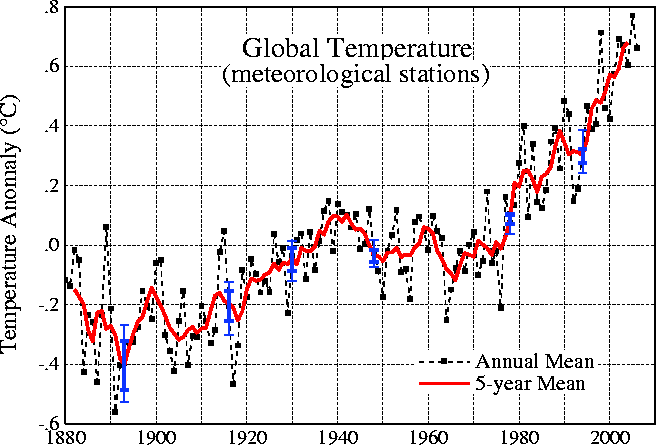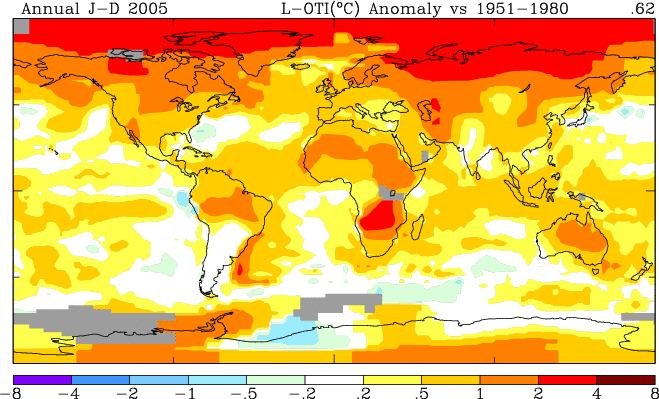Reconstructing Past Climates
A wide range of evidence exists to allow climatologists
to reconstruct the Earth's past climate. This evidence
can be grouped into three general categories.
The first category is meteorological
instrument records. Common climatic
elements measured by instruments include temperature,
precipitation, wind speed, wind direction, and
atmospheric pressure. However, many of these records
are temporally quite short as many of the instruments
used were only created and put into operation during
the last few centuries or decades. Another problem
with instrumental records is that large areas of
the Earth are not monitored. Most of the instrumental
records are for locations in populated areas of
Europe and North America. Very few records exist
for locations in less developed countries (LDCs),
in areas with low human populations, and the Earth's
oceans. Over the last half century many meteorological
stations have been added in land areas previously
not covered. Another important advancement in developing
a global record of climate has been the recent
use of remote satellites.
Written documentation and descriptive
accounts of the weather make up the
second general category of evidence for determining
climate change. Weather phenomena commonly described
in this type of data includes the prevailing character
of the seasons of individual years, reports of
floods, droughts, great frosts, periods of bitter
cold, and heavy snowfalls. Large problems exist
in the interpretation of this data because of its
subjective nature.
Many types of physical and biological
data can provide fossil evidence of
the effects of fluctuations in the past weather
of our planet. Scientists refer to this information
as "proxy
data" of past weather and climate.
Examples of this type of data include tree ring
width and density measurements, fossilized plant
remains, insect and pollen frequencies in sediments,
moraines and other glacial deposits, marine organism
fossils, and the isotope ratios of various elements.
Scientists using this type of data assume uniformity
in the data record. Thus, the response measured
from a physical or biological character existing
today is equivalent to the response of the same
character in the past. However, past responses
of these characters may also be influenced by some
other factor not accounted for. Some common examples
of proxy data include:
Glacial Ice Deposits.
Fluctuations in climate can be determined by the
analysis of gas bubbles trapped in the ice which
reflect the state of the atmosphere at the time they
were deposited, the chemistry of the ice (concentration
or ratio of major ions and isotopes of oxygen and
hydrogen), and the physical properties of the ice.
Biological Marine Sediments.
Climate change can be evaluated by the analysis of
temporal changes in fossilized marine fauna and flora
abundance, morpological changes in preserved organisms,
coral deposits, and the oxygen isotopic concentration
of marine organisms.
Inorganic Marine Sediments.
This type of proxy data includes clay mineralogy,
aeolian terrestial dust, and ice rafted debris.
Terrestrial Geomorphology
and Geology Proxy Data. There are
a number of different types of proxy data types
in this group including glacial deposits, glacial
erosional features, shoreline features, aeolian
deposits, lake sediments, relict soil deposits,
and speleothems (depositional features like stalactites
and stalagmites).
Terrestial Biology Proxy
Data. Variations in climate can be
determined by the analysis of biological data
like annual tree rings, fossilized pollen and
other plant macrofossils, the abundance and distribution
of insects and other organisms, and the biota
in lake sediments.
Earth's Climatic History
Climatologists have used various techniques and evidence
to reconstruct a history of the Earth's past climate.
From this data, they have found that during most of
the Earth's history global temperatures were probably
8 to 15 degrees Celsius warmer than today. In the last
billion years of climatic history, warmer conditions
were broken by glacial periods starting at 925, 800,
680, 450, 330, and 2 million years before present.
The period from 2,000,000 - 14,000 B.P. (before present)
is known as the Pleistocene or Ice
Age. During this period, large glacial ice
sheets covered much of North America, Europe, and Asia
for extended periods of time. The extent of the glacier
ice during the Pleistocene was not static. The Pleistocene
had periods when the glacier retreated (interglacial)
because of warmer temperatures and advanced because
of colder temperatures (glacial).
During the coldest periods of the Ice Age, average
global temperatures were probably 4 - 5 degrees Celsius
colder than they are today.
The most recent glacial retreat is still going on.
We call the temporal period of this retreat the Holocene
epoch. This warming of the Earth and subsequent
glacial retreat began about 14,000 years ago (12,000
BC). The warming was shortly interrupted by a sudden
cooling, known as the Younger-Dryas,
at about 10,000 - 8500 BC. Scientists speculate that
this cooling may have been caused by the release of
fresh water trapped behind ice on North America into
the North Atlantic Ocean. The release altered vertical
currents in the ocean which exchange heat energy with
the atmosphere. The warming resumed by 8500 BC. By
5000 to 3000 BC average global temperatures reached
their maximum level during the Holocene and were 1
to 2 degrees Celsius warmer than they are today. Climatologists
call this period the Climatic
Optimum. During the Climatic Optimum, many
of the Earth's great ancient civilizations began and
flourished. In Africa, the Nile River had three times
its present volume, indicating a much larger tropical
region.
From 3000 to 2000 BC a cooling trend occurred. This
cooling caused large drops in sea level and the emergence
of many islands (Bahamas) and coastal areas that are
still above sea level today. A short warming trend
took place from 2000 to 1500 BC, followed once again
by colder conditions. Colder temperatures from 1500
- 750 BC caused renewed ice growth in continental glaciers
and alpine glaciers, and a sea level drop of between
2 to 3 meters below present day levels.
The period from 750 BC - 800 AD saw warming up to
150 BC. Temperatures, however, did not get as warm
as the Climatic Optimum. During the time of Roman Empire
(150 BC - 300 AD) a cooling began that lasted until
about 900 AD. At its height, the cooling caused the
Nile River (829 AD) and the Black Sea (800-801 AD)
to freeze.
The period 900 - 1200 AD has been called the Little
Climatic Optimum. It represents the warmest
climate since the Climatic Optimum. During this
period, the Vikings established settlements on
Greenland and Iceland. The snow line in the Rocky
Mountains was about 370 meters above current levels.
A period of cool and more extreme weather followed
the Little Climatic Optimum. A great drought in
the American southwest occurred between 1276 and
1299. There are records of floods, great droughts
and extreme seasonal climate fluctuations up to
the 1400s.
From 1550 to 1850 AD global temperatures were at their
coldest since the beginning of the Holocene. Scientists
call this period the Little Ice Age. During the Little
Ice Age, the average annual temperature of the Northern
Hemisphere was about 1.0 degree Celsius lower than
today. During the period 1580 to 1600, the western
United States experienced one of its longest and most
severe droughts in the last 500 years. Cold weather
in Iceland from 1753 and 1759 caused 25% of the population
to die from crop failure and famine. Newspapers in
New England were calling 1816 the year without a summer.
The period 1850 to present is one of
general warming. Figure 7x-1 describes the global
temperature trends from 1880 to 2006. This graph shows
the yearly temperature anomalies that have occurred
from an average global temperature calculated for the
period 1951-1980. The graph indicates that the anomolies
for the first 60 years of the record were consistently
negative. However, beginning in 1935 positive anomolies
became more common, and from 1980 to 2006 most of the
anomolies were between 0.20 to 0.63 degrees Celsius
higher than the normal period (1951-1980) average.

| Figure 7x-1: Near-global
annual-mean temperature change for the period
1880 to 2006 (deviation from the normal period
1951-1980). (Source: NASA
Goddard Institute for Space Studies - Global
Temperature Trends). |
In the 1930s and 1950s, the central United
States experience two periods of extreme drought. In
the seventeen year period from 1990 to 2006, ten of
the warmest years in the last 100 years and possibly
since the Little Climatic Optimum have occurred. Proxy
and instrumental data indicate that 2005 was the warmest
year globally in 1200 years of Earth history. Many
scientists believe the warmer temperatures of the 20th
and 21st centuries are being caused by the human enhancement
of the Earth's greenhouse
effect.

| Figure 7x-2: In
2005, most parts of the world were warmer than
normal. The illustration above describes the
annual temperature deviation (from the base normal
period 1950-1980) in degrees Celsius for the
Earth's surface. This illustration indicates
that it was particularly warm across parts of
Brazil, North America, northern and southern
Africa, Australia, and most of Eurasia. (Source: NASA
Goddard Institute for Space Studies - Global
Temperature Trends). |

